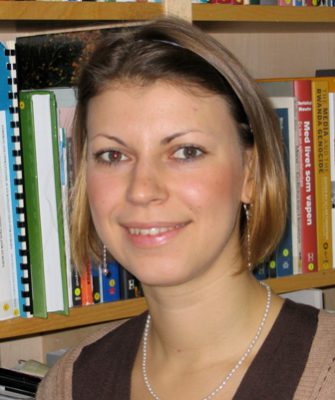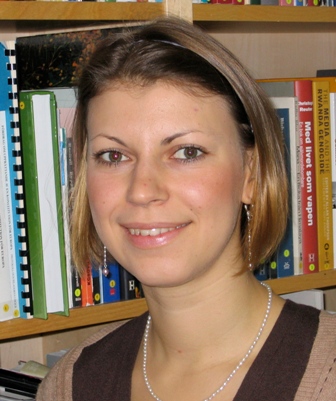Tromsø, 3.3.2011.
|
Petra Granholm is a project researcher at the Åland Islands Peace Institute within the ELDIA project- European Language Diversity for All. Right now, she is researching the legal status of North Sámi and Kven in Norway, but multiculturalism on Åland has previously and presently occupied her mind. petra@peace.ax The blog is written by the peace institute’s present or former staff, guest researchers, board members or invited guest writers. The opinions are the author’s own. |
At the moment, I find myself at the University of Tromsø of Northern Norway, with the task of writing about the legal status of North Sámi and Kven languages in Norway. As a guest researcher, I have the privilege to take part in the dynamics of this border region, both from a professional but also from a personal perspective. I think few of us down “south” think about how international and multiethnic the North Calotte is. Border regions are exciting, that’s where it happens, as we also know on Åland.
Right now, there is a heated language debate in Tromsø. This is because according to law, a municipality can choose to enter the Sámi administrative area, which means certain language rights for the speakers and aspiring speakers of Sámi, and an increased visibility for the indigenous language in the society.
On the North Calotte, there was already a land before the colonial states of Norway, Sweden, Finland and Russia took over. The land is Sápmi, and stretches from the Kola Peninsula in north east to Engerdal in Hedmark, today’s Norway, and Idre in Sweden in south west. This land has been home to the Sámi people, with their different language variteties. However, history made this territory to home also for other groups, many of them of Fenno-Ugric origin, such as Kvens in Norway and Tornedalians in Sweden, but also for the ones that later became the majority population, i.e. Norwegians, Swedes, Finns and Russians. Up here, “the encounter of three tribes” is spoken about when referring to Sámi, Kven and Norwegians. These groups learned each other’s’ language, built boats, were reindeer herders and cultivated the soil, side by side. They married inside but also outside the group and got children, who often were bilingual. With the arrival of nation borders, war and nationalism to the North Calotte, the Fenno-Ugric languages were perceived as threats and were to be opposed. It was tough, sticks and carrots were needed, but at last the efforts were successful in making generations forget about their mother tongues to the benefit of the national languages. Today, when a few decades of multiculturalism and minority protection is changing the policy directions, it is very tricky to revitalize the ancient languages. It costs money, which some of the people who consider themselves Norwegians in Tromsø oppose. “Tromsø is not a Sámi town”, someone says. “Sámi is not natural” someone else says. A third someone goes as far as pointing to conspiracy theories by the Sámi in Finnmark and Troms counties, plans that has been outlined since 1945, in order to take over all the out land in the north. Naturally, the reindeer herding, with its large need of land, ends up in the centre of the storm of emotions from all directions. The North Sámi name of Kåfjord municipality Gáivuona becomes a shooting target on the road sign and the new road sign for Bodø gets the Sámi name of Bådåddjo scribbled over.
But, says the outsider, why is it then so sensitive now, if the North Calotte always has been home to many ethnicities and languages? And what has language issues to do with land issues? Is it perhaps about marking territory from all sides? For my own personal understanding, I have come up with four explanations (although there are certainly more), which may explain people’s reactions against Sámi in Tromsø, but also the reactions in the wake of the financial crisis against the multiculturalism in Europe.
1. The Norwegianisation (in the case of Norwayl) is finished on paper, but not in people’s minds.
2. The Norweganisation is coming with new force, a second wave, a trend that might be an answer to…
3… the perceived “threats” of globalisation against the national languages, the English overtake of more and more domains in society
4… or the “failure of multiculturalism” as it is perceived in Tromsø
I have asked most experts I have stumbled upon during my wanderings her on the university campus of Tromsø and outside, and the answer, as so often, seems to lie in a combination of factors. Ignorance is one explanation; the meaning of identity for the individual is another.
This gave me a reason to contemplate my own identity, which always first and foremost has been Ålandic, despite a life in seven different countries the last ten years. Is the strong Ålandic identity, defined by the invisible but established borders, a blessing or a curse against present and coming multicultural challenges? To what degree has the nation state idea about “one people, one state” taken root in the consciousness of present Ålandic generations? Is it not so, that we easily forget, that Åland is a contribution to the Finnish multiculturalism, a departure from the pure nation-state?
What a chock it was for me as an Ålandic, with Swedish as mother tongue in soul and heart, with my flawed Finnish skills, to participate in a Kven language café a dark winter night in February. I arrived late and had already through email excused my lack of Finnish, not to talk about Kven, language skills. I got the coffee served, took a deep breath and started explaining who I was and what I was doing there in the name of the project – in Finnish of course. After a few sentences the leader of the Kven night interrupted me and asked whether there was a need for translation. Quickly, an older man replied in Kven/Finnish, turned to me and said: “there is not one single person, expect you, who understand what i am saying in this very moment. This is how far the loss of our language has come”. For the first time in my life, i was the best Finnish speaker, just like my dad must have felt when he as Finnish-Swede moved to Åland as a 16-year-old. The man who enlightened me of the Kven circumstances was an old Kven activist, marked with frustration about the inaction of the authorities, but also about the Sámi language status in relation to the Kven status. I quickly got some new information about the number of Kven/Finnish speakers — from my earlier information of 8000-10 000 speakers, he informed me that the real number was about 600-1000, and that he himself probably knew all of them personally. Later I interviewed him and the leader for another Kven association, who told me she was a “confessing Kven”, despite the fact that she had never learned the language. I understood the link later on that night, when they all started singing old Kven and Finnish songs – I have seldom seen such a joy of singing despite the fact that the singers had no clue what they were singing about!
I went to bed that night, and did not know whether I should feel more or less Finnish. Finnish is the dominating language which I rather not speak unless I have to. Despite that I had to admit a certain feeling of privilege in the fact is that I can, even though I might not want to, when there are those who can’t, although they want to. If someone would just cut away everything that is Finnish out of my life, would I miss it? Yes, definitely — both the Swedish and the Finnish culture and language has room inside the framework of my Ålandic identity. And the Icelandic and the German culture also, for that matter! Actually, there is no limit to how much my Ålandic identity can absorb.
Today Åland has one of the oldest and the most successful autonomies in the world. My stubborn conviction is that we have arrived at this through trial and error, through coping with a situation, which might not be the one that the heart most desires, but with a determination to make the best out of it and turn it to an advantage. The world around us changes — world wars rage, iron curtains are erected and torn down, unions are created and borders are opened – and with this change the autonomy also has to change, just like our good autonomy protagonists have understood. In sum – history is a dynamic process, the autonomy is dynamic as well, and the multiculturalism is a part of this process.
————
About the Kven language
Kven is not Finnish, the Kven activists say. It is too simplified to say that Kven is norwegianised Finnish but surely, the Finnish that the immigrants in the north once spoke has been affected by the Norwegian language – for instance when looking at the names of the months: January is januaarikuu, not tammikuu, February is februaarikuu, not helmikuu, etc. Kven is, however, a language under strong threat, how strong a threat nobody knows, because there is no official statistics on the number of speakers and the level of language skills.
About the Sámi languages in Norway
The Lule and South Sámi, not to talk about the in Norway principally extinguished Pite and East/Skolt Sámi, are shadowed by the much greater facade of North Sámi. The North Sámi status in the legislation is stronger than it has ever been, despite the fact that North Sámi, when looking at the number of speakers, still is seen as threatened. For the sake of general knowledge, and the preservation of the smaller Sámi languages, one should perhaps be more consequent and talk about the “Sámi languages” , and denominate the varieties for what they are, different languages, although everyone does not agree with me in that matter. Perhaps it should be dependent on whether one is speaking about the Sámi language at a national or a local level.
For a deeper analysis of multilingualism on the North Calotte, see, for instance:
Pietikäinen, Sari , Huss, Leena , Laihiala-Kankainen, Sirkka , Aikio-Puoskari, Ulla and Lane, Pia (2010),’Regulating Multilingualism in the North Calotte: The Case of Kven, Meänkieli and Sámi Languages’, Acta Borealia, 27:1, pp.1 – 23.
and
Niemi, Einar, ‘National Minorities and Minority Policy in Norway’, in International Obligations and National Debates: Minorities around the Baltic Sea, Spiliopoulou Åkermark, Sia (ed.) Huss, Leena, Oeter, Stefan och Walker, Alastair (co-eds.), pp.397-451.




